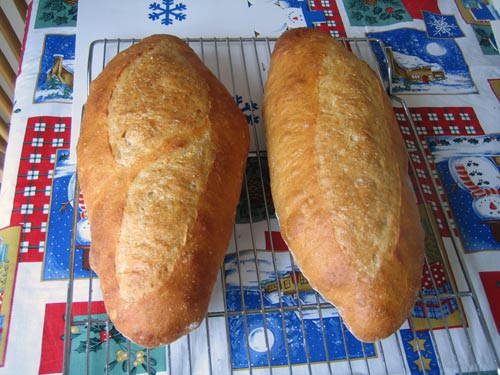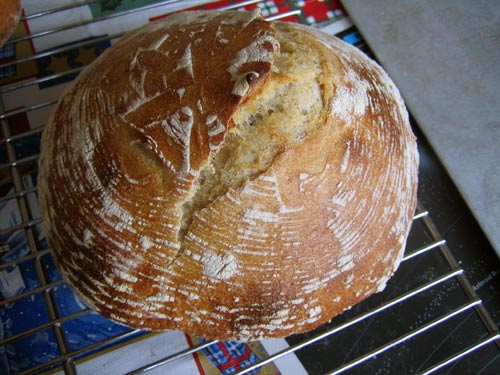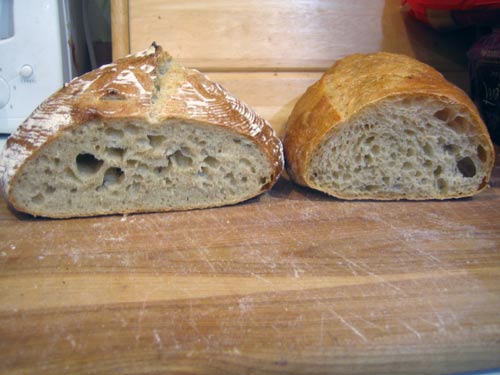As I mentioned in my previous post, last night I placed my new sourdough starter in the oven with just the light on to see if staying 80 degrees overnight would give it some pep. It did, having slightly over doubled in size by this morning.
I also started a poolish last night so I could do a standard French bread if my starter wasn't looking lively. It too was ready to go this morning.
"Hey," I thought, "Since I have both, why don't I try making a yeasted and a sourdough version of the same recipe and compare how they come out? That's a good idea, innit?"
It is if you can remember which is which, but I, alas, could not.
My head was just not together this morning and I mixed up the two. What I knew was that I had two batches of my simple rustic bread: 14 oz. bread flour, 1 oz. rye flour, 1 oz. whole wheat flour, 1 tablespoon salt, 12 ounces water. One of the two had a teaspoon of instant yeast and a cup or so of poolish in it, the other had half a cup of sourdough starter.
For the life of me, I could tell them apart: I was certain the one that was rising fast was the sourdough. It smelled like sourdough. Or maybe that was just the rye flour?
In the end I figured out which was which, but by then I botched the shaping of one of the sourdough loaves. Against all odds, the other one came out well.
The poolish bread:
 The sourdough round:
The sourdough round:
 The two side-by-side (sourdough on left):
The two side-by-side (sourdough on left):
 A close up of the sourdough:
A close up of the sourdough:
 The poolish bread was much lighter and had a much more evenly open crumb. The sourdough was somewhat dense and should have been allowed to rise another half hour or hour (and would have, if I'd remembered which one it was), but it still developed a beautifully irregular crumb and tasted marvelous. That it came out not only edible but excellent proves my assertion that even a dunderhead can bake a naturally leavened bread if they are willing to keep trying.
Next weekend I bake ONLY sourdoughs, or a sourdough and something that I couldn't possibly confuse it with, like a brioche or a challah.
The poolish bread was much lighter and had a much more evenly open crumb. The sourdough was somewhat dense and should have been allowed to rise another half hour or hour (and would have, if I'd remembered which one it was), but it still developed a beautifully irregular crumb and tasted marvelous. That it came out not only edible but excellent proves my assertion that even a dunderhead can bake a naturally leavened bread if they are willing to keep trying.
Next weekend I bake ONLY sourdoughs, or a sourdough and something that I couldn't possibly confuse it with, like a brioche or a challah.
 The sourdough round:
The sourdough round:
 The two side-by-side (sourdough on left):
The two side-by-side (sourdough on left):
 A close up of the sourdough:
A close up of the sourdough:
 The poolish bread was much lighter and had a much more evenly open crumb. The sourdough was somewhat dense and should have been allowed to rise another half hour or hour (and would have, if I'd remembered which one it was), but it still developed a beautifully irregular crumb and tasted marvelous. That it came out not only edible but excellent proves my assertion that even a dunderhead can bake a naturally leavened bread if they are willing to keep trying.
Next weekend I bake ONLY sourdoughs, or a sourdough and something that I couldn't possibly confuse it with, like a brioche or a challah.
The poolish bread was much lighter and had a much more evenly open crumb. The sourdough was somewhat dense and should have been allowed to rise another half hour or hour (and would have, if I'd remembered which one it was), but it still developed a beautifully irregular crumb and tasted marvelous. That it came out not only edible but excellent proves my assertion that even a dunderhead can bake a naturally leavened bread if they are willing to keep trying.
Next weekend I bake ONLY sourdoughs, or a sourdough and something that I couldn't possibly confuse it with, like a brioche or a challah.- Floydm's Blog
- Log in or register to post comments
I've asked this question before on this website, but I'm still a bit confused about the term 'poolish'.
From what I picked up from my last question, it seemed to me that poolish was just another word for 'starter'. Since you differentiate between poolish and 'sourdough starter', it made me wonder if I had the definition right.
Is the term 'poolish' used only for yeasted starters? Or am I missing something here?
There are various kinds of pre-ferments. I haven't got them sorted out yet. But I have recently run across two good references.
In Rose Levy Beranbaum's The Bread Bible, she writes about fermenting and pre-fermenting as the first of "The Ten Essential Steps of Making Bread". Interestingly enough, Fermentation only takes two pages. Then she goes on to write about Pre-fermentation on page 30, detailing five pre-fermentations: old dough, sponge, poolish, biga, and sourdoughs.
Online, at http://www.bakerconnection.com/artisanbaker/article_04.htm, I found an article called "Your Guide to Preferments". It talks about old dough, poolish, sponge, and biga.
I'm sure that there are many more pre-ferment references out there. Rest assured that this is a large topic.
Rosalie
Simply put... a sourdough starter is not made of commercial yeast. And yes, a poolish refers to a pre-ferment made with commercial yeast. (The confusion comes when a recipe includes a sourdough starter made from commercial yeast. Believe me when I tell you I get confused too.) Commercial yeast comes in a package prepared for baking. Yeasts exist just about everywhere and there are many different kinds. Sourdough yeasts are normally found naturally on grains and are developed into sourdough starters. A starter is kept in small quantities and then enlargened in preparation for dough and goes through a name change.
Gosh, I hope I got that right. --Mini Oven